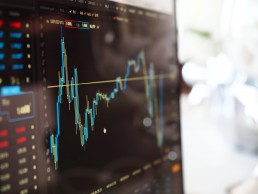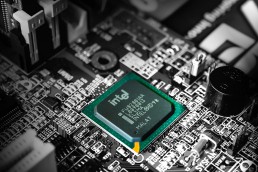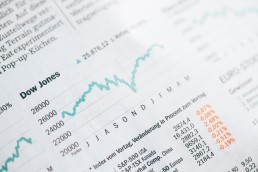Logistics
Have you ever stopped to consider the complex, interconnected systems at work that bring packages to your door? Consider this: while packing for a trip you realize that your destination will be cold this time of year, and after frantically searching through your closet, you cannot seem to find your scarf and decide to order a new one online knowing that it will be delivered the next day. With a few taps on your smartphone, a new scarf is delivered right to your door within 24 hours, and you never even had to get in the car or leave home to make it happen. We often take for granted what an incredible feat this truly is.
[Invest in the technology powering today’s supply chains: the Internet of Things]
The scarf’s rapid delivery is made possible through advanced logistics, which inform the movement of the scarf from a warehouse shelf to a delivery truck via conveyer belt, and delivery truck to your front door. After you place your order and until it is in your hands, logistics is the process that determines the timing, quality, and cost of your order.
What Is Logistics?
The rise of e-commerce over the past 20 years has radically altered consumer purchasing behavior and expectations. Consumers have become more informed shoppers, expertly consulting product reviews and comparing prices from multiple sellers. Sellers, in turn, have aggressively competed with each other to offer increasingly enticing incentives.
One of the most valuable incentives is the seller’s ability to get a product to a customer’s door quickly. According to a 2019 AlixPartners study, the length of time a U.S. consumer was willing to wait for any item ordered online to be delivered to their home in 2014 was a maximum of 5.5 days. By 2019, the maximum wait time decreased to 4.3 days. Furthermore, 72% of U.S. consumers surveyed for the study said that the option of free shipping “greatly impacted” their purchasing decisions.
As a backdrop to increasing customer expectations, the e-commerce sector is expected to see its 10th consecutive year of double-digit growth in 2019, with online sales expected to reach about $587 billion.
In order to tap the explosive growth of e-commerce and other booming sectors, companies must utilize innovative logistics. Companies that implement logistics technology throughout their supply chain gain valuable information on exactly how their products are transported to customers. This information can then be used to streamline processes and save time and money, both of which can then be passed on to customers in the form of faster delivery times and cheaper prices.
For those interested in investing in this rapidly-growing sector, however, there are a few important points to understand.
According to the Michigan State University Department of Supply Chain Management, logistics refers to the “movement, storage, and flow of goods, services and information within the overall supply chain.”
A related but distinct concept is that of supply chain management, which the University further defines as “a way to link major business processes within and across companies into a high-performance business model that drives competitive advantage.”
Alan Amling, Vice President of Corporate Strategy at UPS, explained the nuance of these terms by way of metaphor: “Logistics is the blood, and the supply chain is the body. So if the logistics doesn’t flow–or one part of logistics, whether it’s the transportation, or distribution, or brokerage–if that doesn’t flow, then the supply chain is damaged.”
The Market Opportunity in Logistics
In 2018, U.S. businesses spent $1.6 trillion on logistics. This figure represents the cost to U.S. businesses of storing, shipping, and managing the movement of goods. As a point of reference, $1.6 trillion represents 8% of the U.S.’s 2018 GDP.
Of course, storing and transporting goods efficiently is an important, costly endeavor, and the best companies look for ways to maximize those costs. One of the most important ways companies can do this is by investing in new technology that improves the performance of logistics and supply chains. Digitization and automation, for instance, have the potential to radically modernize how goods are moved from one place to another. The savings produced by technologies like these are tremendous, as are the potential earnings for investors aligned with the company selling or implementing the technology.
According to a November 2018 study by American Global Logistics and Logistics Trends & Insights, U.S. companies are projected to make $87.8 billion in new logistics and supply chain investments by 2022.
The scale of these projected investments are already becoming apparent. In June 2018, Home Depot announced it would be investing $1.2 billion over the next five years to build new distribution facilities across the U.S. in order to speed up deliveries. In July 2019, Walmart announced it would be investing $1.2 billion over the next 10-20 years to build and upgrade grocery distribution centers in China.
Large, well-managed companies already recognize that investing big in logistics is essential for maintaining a long-term competitive advantage. Furthermore, it is not enough for existing processes merely to evolve with the times; outright disruption is going to be an essential component for recognizing and capturing savings.
Venture capitalists understand the potential value of disruptive energy in logistics and transportation, and they are correspondingly making big investments in these areas. According to CB Insights, trucking and freight startups raised $3.6 billion in venture capital funds in 2018, double the amount collected in 2017.
And 2019 is projected to be another huge year for logistics funding, led by deals like SoftBank Vision Fund’s $1 billion investment in Flexport, a startup specializing in freight forwarding and customs brokerage. In a company blog post announcing the investment, the CEO of Flexport, Ryan Peterson, noted that: “The human brain has a strong unconscious bias against tackling really difficult problems. It’s probably one of the big reasons no one before us has succeeded in modernizing our centuries-old industry; it’s a massive, hairy, complex system that’s held back by the inexorable power of inertia … Flexport is dedicated to disrupting this idleness and seeking to make global trade easier and more accessible for everyone.”
Innovative companies like Flexport are going to continue to challenge the status quo as they seek to modernize logistics, and savvy investors would be wise to pay attention.
How to Invest in Logistics
A search on Magnifi suggests that there are a number of ways to profit from the rise of logistics as a business.
Unlock a World of Investing with a Magnifi Account
Magnifi is changing the way we shop for investments, with the world’s first semantic search engine for finance that helps users discover, compare and buy investment products such as ETFs, mutual funds and stocks. Open a Magnifi investment account today.
The information and data are as of the November 27, 2019 (publish date) unless otherwise noted and subject to change. This blog is sponsored by Magnifi.
Mobile Payments
When is the last time you wrote a check to pay for something or left the house with a set amount of cash in your wallet for errands? For a growing number of people worldwide, it is entirely possible that they may not be able to recall. In the U.S., the use of credit and debit cards have largely replaced the use of checks, and carrying cash is increasingly seen as unnecessary and inconvenient. This dramatic transformation of our payment practices can be explained in part by the emergence of mobile payment technology for smartphones in recent years.
The rise of mobile payments has transformed the way we pay for everyday items and simplified how we share money with one another.
With smartphones in almost everyone’s pockets and apps that transfer money digitally in seconds, the days of frantically searching for an ATM or cursing yourself for leaving your wallet at home are coming to an end. Who needs a checkbook when you can quickly transfer your friend that $25 you owe them with a few taps on your smartphone?
What Are Mobile Payments?
According to Square, a leading mobile payment technology company, mobile payments are defined as “regulated transactions that take place digitally through your mobile device.”
Most mobile payments are conducted through a mobile wallet or mobile money transfer. A mobile wallet is a smartphone app that securely stores credit or debit card information. This information can be digitally communicated to a business’s point-of-sale system by holding the smartphone near the business’s payment reader.
Popular mobile wallet apps include Apple Pay, Samsung Pay, and Android Pay, and companies that provide businesses with software and devices to accept mobile payments include Square, SumUp, and PayPal.
In the case of mobile money transfers (also sometimes referred to as “peer-to-peer” or “P2P” payments), funds are transferred between users on an app. Typically, a user creates an account on the app, links their bank account, debit card, and/or credit card information with the app, and “adds” accounts of other individuals who use the app. Money may then be requested from or sent to the accounts of these individuals.
Popular money transfer apps include Venmo, WorldRemit, and Azimo.
Mobile payment companies monetize the services they offer in a variety of ways. Square, for instance, charges businesses a fee ranging from 2.5% to 3.5% for each transaction (with a flat fee of 10 cents added to each transaction fee). Venmo, on the other hand, charges its users a 3% fee for sending money via credit card instead of debit card. Both companies offer expedited access to transferred funds for a fee. Since its November 2015 IPO, the stock price for Square has risen from about $8 per share to about $65 per share (as of November 2019). Since its July 2015 spinoff from eBay, the stock price for PayPal (Venmo’s parent company) has risen from about $40 per share to about $103 per share (as of November 2019).
A Fast Growing Market
According to a 2018 report by GSMA, 143 million new mobile payment accounts were opened worldwide in 2018, bringing the total number of accounts to 866 million. Approximately $1.30 billion was processed every day via mobile payment in 2018, and a typical active user moved an average of $206 per month.
The speed, efficiency, and security offered by mobile payments help explain why this technology has become so popular across the globe. The rise in this technology is also providing people who have traditionally been excluded from formal banking systems with access to life-changing financial services.
According to the World Bank, “Financial inclusion is a building block for both poverty reduction and opportunities for economic growth, with access to digital financial services critical for joining the new digital economy.”
Why Invest in Mobile Payments?
For those interested in investing in this rapidly-growing sector, however, there are a few important points to understand.
The mobile payment companies mentioned thus far are undeniably successful. Square’s total net revenue in the third quarter of 2019 was $1.27 billion, which is a 44% increase over 2018’s third quarter earnings. PayPal’s total net revenue for the same quarter was $4.38 billion, with Venmo accounting for $400 million (double the $200 million from the third quarter in 2018). With steady growth and a seemingly-unlimited appetite for disrupting the value of traditional financial institutions, there has never been a better time to consider investing in companies offering mobile payment solutions.
While Square and Venmo may be the first that come to mind with respect to mobile payments in the U.S., there are many other companies that have arisen in recent years in other parts of the world that are just as innovative and, in terms of active users, arguably more successful. Whether it’s WeChat Pay in China, Paytm in India, or M-PESA in Kenya, entrepreneurs across the globe have known about the transformative potential of mobile payments for years.
The acceptance of mobile payments as a trusted and valued financial tool has occurred at a faster rate and to greater effect in the developing world than in the U.S. For instance, an eMarketer report found that in 2019, approximately 80% of smartphone users in China regularly use mobile payments, while only about 30% of smartphone users in the U.S. regularly make mobile payments.
It may seem as if there would be no room for growth with 80% of users currently accounted for in China’s market, but it is important to note that the 20% of smartphone users not regularly making mobile payments represent about 135 million people.
Not to mention, the 70% of smartphone users in the U.S. not regularly making mobile payments represent about 138 million people. Smartphone users in the U.S. have been slow to adopt mobile payments en masse, due in part to a widespread perceived risk regarding the security of digitally-transferred funds. As the population in the U.S. ages and more accurate information about the security and convenience of mobile payments filters out, it is likely that a much higher percentage of the population will adopt the technology.
In the meantime, companies at the cutting edge of mobile payment innovation will continue to reimagine and redefine how we think about our finances.
How to Invest in Mobile Payments
A search on Magnifi suggests that there are a number of different ways for investors to get involved in the fast growing Mobile Payments sector.
Unlock a World of Investing with a Magnifi Account
Magnifi is changing the way we shop for investments, with the world’s first semantic search engine for finance that helps users discover, compare and buy investment products such as ETFs, mutual funds and stocks. Open a Magnifi investment account today.
The information and data are as of the November 20, 2019 (publish date) unless otherwise noted and subject to change. This blog is sponsored by Magnifi.
TQQQ
Like the Invesco QQQ ETF (QQQ), the ProShares UltraPro QQQ (TQQQ) tracks the tech-focused NASDAQ-100 index, but in the case of TQQQ it is seeking daily investment results that are three times the daily performance of the NASDAQ-100. It does this by trading on leverage and actively entering and exiting trades throughout the day.
Common uses for a leverage ETF like TQQQ include: Seeking magnified gains (will also magnify losses), getting a target level of exposure for less cash and overweighting a market segment without additional cash.
TQQQ’s expense ratio is 0.98% and it currently has about $3.7 billion in assets under management.
Rationale
Naturally, the most direct way to gain exposure to the TQQQ approach to the market is to buy its listed shares. But there are a number of good reasons for investors to reconsider that approach. For one thing, the tech-focused NASDAQ is famously volatile, so a leveraged ETF like TQQQ is effectively taking a risky and volatile index and making it 3x more so. Rather than buying TQQQ shares themselves, investors interested in a technology ETF that’s either more conservative or more aggressive might consider buying funds that provide exposure to its top-weighted sectors, in order to manage their investments more directly than via TQQQ.
Investing in TQQQ
A search on Magnifi suggests that investors can gain access to the NASDAQ-100 via a number of different funds and other ETFs, including those shown below.
Schedule a demo and unlock
a 14-day free trial of Magnifi Pro+
Magnifi is changing the way we shop for investments, with the world’s first semantic search engine for finance that helps users discover, compare and buy investment products such as ETFs, mutual funds and stocks. Open a Magnifi investment account today.
This blog is sponsored by Magnifi. The information and data are as of the publish date unless otherwise noted and subject to change. This material is provided for informational purposes only and should not be construed as individualized investment advice or an offer or solicitation to buy or sell securities tailored to your needs. This information covers investment and market activity, industry or sector trends, or other broad-based economic or market conditions and should not be construed as investment research or advice. Investors are urged to consult with their financial advisors before buying or selling any securities. Although certain information has been obtained from sources believed to be reliable, we do not guarantee its accuracy, completeness or fairness. Past performance is no guarantee of future results. This content may not be reproduced or distributed to any person in whole or in part without the prior written consent of Magnifi. [As a technology company, Magnifi provides access to tools and will be compensated for providing such access. Magnifi does not provide broker-dealer, custodian, investment advice or related investment services.]
DIA
First assembled in 1896, the Dow Jones Industrial Average is a stock market index that tracks the performance of 30 “blue chip” companies across a range of industries on U.S. exchanges. It is not weighted by market cap or arithmetic mean, though it is price weighted and does offer a broad snapshot of the performance of U.S. stocks at any given moment. The SPDR Dow Jones Industrial Average ETF Trust (DIA) is designed to follow the performance of this index.
DIA holds 30 companies across nine sectors, including Industrials (making up 20.35% of the portfolio), Information Technology (19.69%), Financials (14.91%), Consumer Discretionary (13.62%), Health Care (11.76%), Consumer Staples (8.89%), Communication Services (4.80%), Energy (4.77%) and Materials (1.20%). Its top 10 holdings are Boeing (9.58%), Home Depot (5.84%), Apple (5.64%), UnitedHealth (5.47%), McDonald’s (5.40%), Goldman Sachs (5.22%), Visa (4.33%), 3M (4.14%), Travelers (3.74%) and IBM (3.66%).
DIA’s gross expense ratio is 0.17% and it currently has about $275 billion in assets under management.
Rationale
The most direct way to gain exposure to the holdings in DIA is to buy its listed shares. But there are a number of good reasons for investors to reconsider that approach. Unlike total market ETFs, DIA is weighted to mirror the Dow Jones Industrial Average, rather than broader weighted indexes like the S&P 500. This potentially ties investment outcomes to the Dow’s weightings, limiting returns from a broader index. Rather than buying DIA shares themselves, investors interested in gaining exposure to the Dow components might consider buying funds that provide exposure to its top-weighted sectors, including Industrials, Information Technology and Financials. After all, the return drivers that will benefit DIA might also benefit other funds that are even more diversified.
Investing in DIA
A search on Magnifi suggests that investors can gain access to the Dow Jones Industrial Average via a number of different funds and other ETFs, including those shown below.
Schedule a demo and unlock
a 14-day free trial of Magnifi Pro+
Magnifi is changing the way we shop for investments, with the world’s first semantic search engine for finance that helps users discover, compare and buy investment products such as ETFs, mutual funds and stocks. Open a Magnifi investment account today.
This blog is sponsored by Magnifi. The information and data are as of the publish date unless otherwise noted and subject to change. This material is provided for informational purposes only and should not be construed as individualized investment advice or an offer or solicitation to buy or sell securities tailored to your needs. This information covers investment and market activity, industry or sector trends, or other broad-based economic or market conditions and should not be construed as investment research or advice. Investors are urged to consult with their financial advisors before buying or selling any securities. Although certain information has been obtained from sources believed to be reliable, we do not guarantee its accuracy, completeness or fairness. Past performance is no guarantee of future results. This content may not be reproduced or distributed to any person in whole or in part without the prior written consent of Magnifi. [As a technology company, Magnifi provides access to tools and will be compensated for providing such access. Magnifi does not provide broker-dealer, custodian, investment advice or related investment services.]
VTI
Like the SPDR S&P 500 ETF (SPY), the Vanguard Total Stock Market ETF (VTI) is designed to track the performance of the overall U.S. stock market, but with a slight twist that can impact results. Unlike SPY, Vanguard’s offering mirrors the CRSP US Total Market Index, including large-, mid- and small-cap equities that are diversified across growth and value styles, offering a broad snapshot of the market as a whole.
VTI holds a wide range of companies across 10 sectors, including: Basic Materials (2.20%), Consumer Goods (8.00%), Consumer Services (13.40%), Financials (19.80%), Health Care (12.70%), Industrials (13.30%), Oil & Gas (4.00%), Technology (21.20%), Telecommunications (2.00%), and Utilities (3.40%). As of October 2019, its 10 largest holdings, accounting for 19.40% of total net assets are Microsoft, Apple, Alphabet, Amazon, Facebook, Berkshire Hathaway, JPMorgan Chase, Johnson & Johnson, Procter & Gamble and Visa.
The ETF’s gross expense ratio is 0.03% and VTI currently has about $845 billion in assets under management.
Rationale
Naturally, the most direct way to gain exposure to the holdings in VTI is to buy its listed shares. But there are a number of good reasons for investors to reconsider that approach. Unlike SPY, VTI is weighted to mirror the CRSP US Total Market Index, rather than directly tied to the S&P 500’s focus. This exposes investors to sectors of the stock market that may not be as heavily invested as most S&P-focused funds. Rather than buying VTI shares themselves, investors interested in gaining exposure to this broad index might consider buying funds that provide exposure to its top-weighted sectors, including technology, financials and consumer goods, in order to spread out their investments even more broadly than VTI does. After all, the return drivers that will benefit VTI might also benefit other funds that are even more diversified.
Investing in VTI
A search on Magnifi suggests that investors can gain access to the CRSP US Total Market Index via a number of different funds and other ETFs, including those shown below.
Schedule a demo and unlock
a 14-day free trial of Magnifi Pro+
Magnifi is changing the way we shop for investments, with the world’s first semantic search engine for finance that helps users discover, compare and buy investment products such as ETFs, mutual funds and stocks. Try it for yourself today.
This blog is sponsored by Magnifi. The information and data are as of the publish date unless otherwise noted and subject to change. This material is provided for informational purposes only and should not be construed as individualized investment advice or an offer or solicitation to buy or sell securities tailored to your needs. This information covers investment and market activity, industry or sector trends, or other broad-based economic or market conditions and should not be construed as investment research or advice. Investors are urged to consult with their financial advisors before buying or selling any securities. Although certain information has been obtained from sources believed to be reliable, we do not guarantee its accuracy, completeness or fairness. Past performance is no guarantee of future results. This content may not be reproduced or distributed to any person in whole or in part without the prior written consent of Magnifi. [As a technology company, Magnifi provides access to tools and will be compensated for providing such access. Magnifi does not provide broker-dealer, custodian, investment advice or related investment services.]
SMH
The VanEck Vectors Semiconductor ETF (SMH) is designed to replicate the MVIS US Listed Semiconductor 25 Index, which tracks the overall performance of companies involved in semiconductor production and equipment. Beyond that, SMH focuses on the most liquid companies in the industry based on market cap and trading volume, with a bias toward large, well-established semiconductor companies. It invests in both domestic and U.S. listed foreign companies.
SMH’s top holdings include Taiwan Semiconductor Manufacturing Co. (13.42%), Intel (11.80%), Nvidia (5.77%), Texas Instruments (5.19%), Asml Holding (5.11%), Lam Research (4.89%), Advanced Micro Devices (4.85%), Qualcomm (4.81%) Broadcom (4.70%) and Applied Material (4.53%). Companies in the United States makes up 74.77% of its portfolio, followed by Taiwan at 13/42% and the Netherlands at 9.55%.
SMH’s expense ratio is 0.39% and it currently has about $1.6 billion in assets under management.
Rationale
The most direct way to gain exposure to the holdings in SMH is to buy its listed shares. But there are a number of good reasons for investors to reconsider that approach. While SMH seeks to mirror the global semiconductor market, there are different weightings and investment approaches to this sector that might perform differently in different investment environments. Rather than buying SMH shares themselves, investors interested in a semiconductor ETF that’s weighted differently or takes a more global approach might consider buying funds that provide exposure to similar semiconductor firms. After all, the return drivers that will benefit SMH might also benefit other funds focused on the semiconductor space.
Investing in SMH
A search on Magnifi suggests that investors can gain access to the semiconductor market via a number of different funds and other ETFs, including those shown below.
Schedule a demo and unlock
a 14-day free trial of Magnifi Pro+
Magnifi is changing the way we shop for investments, with the world’s first semantic search engine for finance that helps users discover, compare and buy investment products such as ETFs, mutual funds and stocks. Open a Magnifi investment account today.
This blog is sponsored by Magnifi. The information and data are as of the publish date unless otherwise noted and subject to change. This material is provided for informational purposes only and should not be construed as individualized investment advice or an offer or solicitation to buy or sell securities tailored to your needs. This information covers investment and market activity, industry or sector trends, or other broad-based economic or market conditions and should not be construed as investment research or advice. Investors are urged to consult with their financial advisors before buying or selling any securities. Although certain information has been obtained from sources believed to be reliable, we do not guarantee its accuracy, completeness or fairness. Past performance is no guarantee of future results. This content may not be reproduced or distributed to any person in whole or in part without the prior written consent of Magnifi. [As a technology company, Magnifi provides access to tools and will be compensated for providing such access. Magnifi does not provide broker-dealer, custodian, investment advice or related investment services.]
QQQ
Another of the oldest exchange traded funds (ETFs) on the market, the Invesco QQQ ETF (QQQ) was launched in 1999 as a way for investors to track the tech-focused NASDAQ-100 index. Now, two decades into its run, QQQ remains in the top 1% of all NASDAQ-focused ETFs in terms of assets under management. As of 2019, QQQ has maintained a top 1% ranking in the Lipper’s Large-Cap Growth Category for the past 10 and 15 years and is the second-most traded ETF in the U.S. based on average daily volume.
QQQ’s holdings are broken down into six categories, each weighted differently. Information technology gets 44.44%, Communications 21.40%, Consumer Discretionary 16.90%, Healthcare 7.98% Consumer Staples 6.07% and Industrials & Utilities 2.83%. Its top holdings include Microsoft (11.21%), Apple (9.95%), Cisco (2.84%), Intel (2.60%, Adobe (1.74%), Paypal (1.63%), Broadcom (1.38%), Texas Instruments (1/31%), Nvidia (1.21%) and Qualcomm (1.12%).
QQQ’s expense ratio is 0.20% and it currently has about $82 billion in assets under management.
Rationale
Naturally, the most direct way to gain exposure to the holdings in QQQ is to buy its listed shares. But there are a number of good reasons for investors to reconsider that approach. There are a number of different versions of the QQQ approach, each with slightly different weightings, and for good reason. The tech-focused NASDAQ is famously volatile, so ETFs that track it generally try to smooth out these ups and downs through more active management and different weightings. Rather than buying QQQ shares themselves, investors interested in a technology ETF that’s either more conservative or more aggressive might consider buying funds that provide exposure to its top-weighted sectors, in order to spread out their investments even more broadly than QQQ does. After all, the return drivers that will benefit QQQ might also benefit other funds that are even more diversified.
Investing in QQQ
A search on Magnifi suggests that investors can gain access to the NASDAQ-100 via a number of different funds and other ETFs, including those shown below.
Schedule a demo and unlock
a 14-day free trial of Magnifi Pro+
Magnifi is changing the way we shop for investments, with the world’s first semantic search engine for finance that helps users discover, compare and buy investment products such as ETFs, mutual funds and stocks. Open a Magnifi investment account today.
This blog is sponsored by Magnifi. The information and data are as of the publish date unless otherwise noted and subject to change. This material is provided for informational purposes only and should not be construed as individualized investment advice or an offer or solicitation to buy or sell securities tailored to your needs. This information covers investment and market activity, industry or sector trends, or other broad-based economic or market conditions and should not be construed as investment research or advice. Investors are urged to consult with their financial advisors before buying or selling any securities. Although certain information has been obtained from sources believed to be reliable, we do not guarantee its accuracy, completeness or fairness. Past performance is no guarantee of future results. This content may not be reproduced or distributed to any person in whole or in part without the prior written consent of Magnifi. [As a technology company, Magnifi provides access to tools and will be compensated for providing such access. Magnifi does not provide broker-dealer, custodian, investment advice or related investment services.]
SPY
Exchange traded funds (ETFs) are now one of the most popular publicly-traded investment vehicles on the market, with nearly $3.5 trillion in assets under management across all ETFs as of 2018, and it all started with the SPDR S&P 500 ETF Trust (SPY), which launched as the first-ever ETF on January 22, 1993. Named for the Standard & Poor’s Depositary Receipts, SPY tracks the S&P 500 stock market index and is today the largest ETF in the world with roughly $280 billion in assets under management.
The S&P 500 Index holds large cap U.S. companies across all 11 GICS sectors, and SPY is designed to mirror that weighting, effectively tracking the broad U.S. stock market. SPY’s top holdings include (in order): Microsoft (4.43%), Apple (4.37%), Amazon (2.81%), Facebook (1.85%), Berkshire Hathaway Class B (1.66%), JPMorgan Chase (1.61%), Alphabet (1.53% Class C and 1.52% Class A), Johnson & Johnson (1.37%) and Visa (1.22%).
The ETF’s gross expense ratio is 0.0945% and each share is designed to be worth 1/10 of the cash S&P 500’s current level.
Rationale
Naturally, the most direct way to gain exposure to the holdings in SPY is to buy its listed shares. But there are a number of good reasons for investors to reconsider that approach. SPY is weighted to directly mirror the S&P 500, with a heavy focus toward technology, but it is worth considering if that is the correct approach going forward. Rather than buying SPY shares themselves, investors interested in gaining exposure to the broad S&P 500 Index might consider buying funds that provide exposure to its top-weighted sectors, including information technology, healthcare and energy, in order to spread out their investments even more broadly than SPY does. After all, the return drivers that will benefit SPY might also benefit other funds that are even more diversified.
Investing in SPY
A search on Magnifi suggests that investors can gain access to the S&P 500 via a number of different funds and other ETFs, including those shown below.
Schedule a demo and unlock
a 14-day free trial of Magnifi Pro+
Magnifi is changing the way we shop for investments, with the world’s first semantic search engine for finance that helps users discover, compare and buy investment products such as ETFs, mutual funds and stocks. Open a Magnifi investment account today.
This blog is sponsored by Magnifi. The information and data are as of the publish date unless otherwise noted and subject to change. This material is provided for informational purposes only and should not be construed as individualized investment advice or an offer or solicitation to buy or sell securities tailored to your needs. This information covers investment and market activity, industry or sector trends, or other broad-based economic or market conditions and should not be construed as investment research or advice. Investors are urged to consult with their financial advisors before buying or selling any securities. Although certain information has been obtained from sources believed to be reliable, we do not guarantee its accuracy, completeness or fairness. Past performance is no guarantee of future results. This content may not be reproduced or distributed to any person in whole or in part without the prior written consent of Magnifi. [As a technology company, Magnifi provides access to tools and will be compensated for providing such access. Magnifi does not provide broker-dealer, custodian, investment advice or related investment services.]
JNUG
The Direxion Daily Junior Gold Miners Index (JNUG) is tied to the performance of the MVIS Global Junior Gold Miners Index, which tracks the performance of foreign and domestic micro-, small- and mid-cap gold and silver mining companies. But JNUG adds a layer to the typical index ETF approach, seeking daily investment results that are three times that of the underlying index. It accomplishes this through the use of leverage.
JNUG’s top holdings include Kinross Gold (6.12% weighting), Evolution Mining (5.59%), Northern Star Resources (4.91%), Pan American (4.27%), Gold Fields (4.14%), Comp De Minas (4.05%), Yamana Gold (3.88%), Sibanye Gold (3.39%), B2Gold (3.03%), and Detour Gold (2.87%).
JNUG’s expense ratio is 1.17% and it currently has about $935 million in assets under management.
Rationale
The most direct way to gain exposure to the holdings in JNUG is to buy its listed shares. But there are a number of good reasons for investors to reconsider that approach. JNUG is just one of a pair of ETFs that are tracking the gold miners market. JNUG is the bullish (upside) listing, while JDST is the bearish (downside) short version. Both intend to deliver positive results but are optimized for opposite market conditions. This said, rather than buying JNUG shares themselves, investors interested in gaining exposure to the gold mining market as a whole might consider buying funds that provide exposure to its top-weighted companies. After all, the return drivers that will benefit JNUG might also benefit other funds in the sector.
Investing in JNUG
A search on Magnifi suggests that investors can gain access to the gold miners of the world via a number of different funds and other ETFs, including those shown below.
Schedule a demo and unlock
a 14-day free trial of Magnifi Pro+
Magnifi is changing the way we shop for investments, with the world’s first semantic search engine for finance that helps users discover, compare and buy investment products such as ETFs, mutual funds and stocks. Open a Magnifi investment account today.
This blog is sponsored by Magnifi. The information and data are as of the publish date unless otherwise noted and subject to change. This material is provided for informational purposes only and should not be construed as individualized investment advice or an offer or solicitation to buy or sell securities tailored to your needs. This information covers investment and market activity, industry or sector trends, or other broad-based economic or market conditions and should not be construed as investment research or advice. Investors are urged to consult with their financial advisors before buying or selling any securities. Although certain information has been obtained from sources believed to be reliable, we do not guarantee its accuracy, completeness or fairness. Past performance is no guarantee of future results. This content may not be reproduced or distributed to any person in whole or in part without the prior written consent of Magnifi. [As a technology company, Magnifi provides access to tools and will be compensated for providing such access. Magnifi does not provide broker-dealer, custodian, investment advice or related investment services.]
UVXY
As a leveraged fund, the ProShares Ultra VIX Short-Term Futures ETF (UVXY) seeks daily investment results that are one and one-half times (1.5x) the daily performance of the S&P 500 VIX Short-Term Futures Index, which tracks a portfolio of monthly VIX futures contracts. It’s a play on U.S. stock market volatility.
As a leverage ETF, UVXY is designed to help investors profit from increases in the expected volatility of the S&P 500 while also reducing their portfolio risk, since changes in the VIX Short-Term Futures Index have historically been negatively correlated to S&P 500 returns.
UVXY’s expense ratio is 0.95% and it has about $584 million in assets under management.
Rationale
The most direct way to gain exposure to the UVXY approach to the short-term VIX is to buy its listed shares. But there are a number of good reasons for investors to reconsider that. UVXY gas underperformed broadly since inception in 2011, amid a fairly steady growth period for the overall U.S. equities market. This mirrors the trend in the VIX overall. Rather than buying UVXY shares themselves, investors interested in gaining exposure to both short- and mid-term protection that’s tied to the VIX might consider buying funds that provide exposure to similar VIX positions.
Investing in UVXY
A search on Magnifi suggests that investors can gain access to the VIX via a number of different funds and other ETFs, including those shown below.
Schedule a demo and unlock
a 14-day free trial of Magnifi Pro+
Magnifi is changing the way we shop for investments, with the world’s first semantic search engine for finance that helps users discover, compare and buy investment products such as ETFs, mutual funds and stocks. Open a Magnifi investment account today.
This blog is sponsored by Magnifi. The information and data are as of the publish date unless otherwise noted and subject to change. This material is provided for informational purposes only and should not be construed as individualized investment advice or an offer or solicitation to buy or sell securities tailored to your needs. This information covers investment and market activity, industry or sector trends, or other broad-based economic or market conditions and should not be construed as investment research or advice. Investors are urged to consult with their financial advisors before buying or selling any securities. Although certain information has been obtained from sources believed to be reliable, we do not guarantee its accuracy, completeness or fairness. Past performance is no guarantee of future results. This content may not be reproduced or distributed to any person in whole or in part without the prior written consent of Magnifi. [As a technology company, Magnifi provides access to tools and will be compensated for providing such access. Magnifi does not provide broker-dealer, custodian, investment advice or related investment services.]









